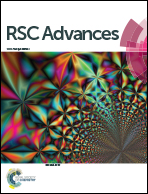Dissolving microneedles delivering cancer cell membrane coated nanoparticles for cancer immunotherapy†
Abstract
Recently, a variety of tumor vaccines and immune system stimulators such as toll-like receptor (TLR) agonists have been widely investigated for cancer immunotherapy via transdermal delivery. Despite these great research efforts, low efficiency and discomfort remain a huge technical hurdle for the development of immunotherapeutics. Here, we design a facile method to deliver drugs to the skin through microneedles (MNs) to stimulate the immune system in two ways. As one of the tumor vaccines, cancer cell membrane proteins can act as tumor-specific antigens that are presented to antigen presenting cells (APCs) to activate the immune system. In addition, a toll-like receptor 7 (TLR7) agonist of imiquimod (R837) can suppress cancer cell growth by inhibiting angiogenesis. Using poloxamer 407 (F127) as a nanocarrier, F127 nanoparticles (F127 NPs) are loaded with R837 and then coated with cancer cell membranes (M). These F127–R837@M NPs are loaded in rapidly dissolving MNs and delivered through the skin. MNs loaded with F127–R837@M NPs show significant inhibition of cancer cell growth in both prophylactic vaccination and antitumor immunotherapy in vivo. The dual immune system stimulating F127–R837@M NPs could be effectively used for cancer immunotherapy.



 Please wait while we load your content...
Please wait while we load your content...